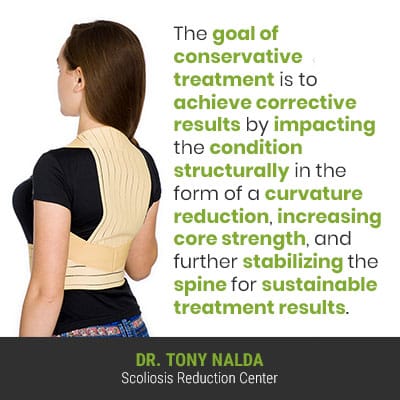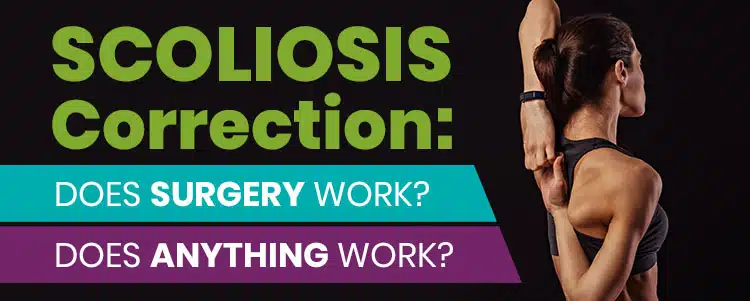There are two main approaches to scoliosis treatment: the traditional surgical approach and a modern non-surgical chiropractic-centered approach, aka conservative. Each approach has a different end goal. Traditional treatment focuses on stopping progression, while conservative treatment focuses on a correction. While nothing can cure scoliosis, proactive treatment can achieve scoliosis correction.
Correcting scoliosis means achieving a curvature reduction on a structural level. As a structural spinal condition, scoliosis treatment has to address the condition’s underlying structural nature. While scoliosis is incurable, with proactive treatment, it is highly treatable.
For those recently diagnosed with scoliosis, it’s common to be flooded with questions and concerns, the most pressing of which being how to treat it moving forward.
Can Scoliosis Be Corrected?
When I tell a patient they have scoliosis; there are some common questions I’m met with, the most common of which is, “Is it curable?”
This is a hard one to answer because, as a structural progressive spinal condition, scoliosis has, in its nature to worsen over time, but although it’s not curable, it is highly treatable.
In the context of scoliosis, a correction means impacting the condition structurally with a curvature reduction. Scoliosis being a structural condition, means there is a flaw within the spine itself.
The spine consists of vertebrae (bones of the spine) stacked on top of one another, separated by intervertebral discs, in a straight and neutral alignment.
Scoliosis means having an unnatural sideways spinal curve, with rotation, and a minimum Cobb angle of 10 degrees.
A patient’s Cobb angle measurement is taken during X-ray and tells me how far out of alignment a scoliotic spine is, while placing conditions on a severity scale of:
- Mild scoliosis: Cobb angle measurement of between 10 and 25 degrees
- Moderate scoliosis: Cobb angle measurement of between 25 and 40 degrees
- Severe scoliosis: Cobb angle measurement of 40+ degrees
- Very-severe scoliosis: Cobb angle measurement of 80+ degrees
The higher the Cobb angle, the more severe the condition, and as a progressive condition, where scoliosis is at the time of diagnosis is not indicative of where it will stay, particularly if left untreated or not treated proactively.
Mild scoliosis can easily progress to moderate, severe, or very severe; the only way to effectively counteract the condition’s progressive nature is through proactive treatment.
Scoliosis Correction Options
So can scoliosis be corrected? Yes, it can, but not by surgery; treatment has to have corrective potential.

Spinal fusion surgery doesn’t have correction as its end goal, focusing instead on stopping progression, but stopping a scoliotic curve from getting worse is not the same as correcting scoliosis.
Again, correcting scoliosis has to involve impacting it on a structural level; surgery, offered under the traditional scoliosis treatment approach, fuses the most-tilted vertebrae of the curve together into one solid bone so the curve can’t increase in size, with no guarantee that it will be successful at preventing further progression.
While there are different types of spinal fusion, the procedure commonly involves attaching rods to the spine with screws to hold the spine in place, and the hardware attached is permanent.
The risk of an adverse reaction to the hardware used, hardware failure, or hardware simply reaching its expiration are all very-real risks that should be considered.
Also, considering that the age group most commonly diagnosed with scoliosis (adolescents between the ages of 10 and 18), the hardware has to last a long time.
Metal rods can weaken over time, break, crack, and screws can come loose, with the potential to cause some severe complications; after all, the procedure does add foreign elements inside the body.
If there is a hardware-related issue, the only recourse is more surgery and facing the associated risks all over again, and as is the case with most surgical procedures, risks only increase with age.
So while spinal fusion can be successful at straightening a crooked spine, the results aren’t considered corrective because of the way in which the spine is straightened: through artificial means.
In addition, there are also significant scoliosis surgery risks and potential side effects, and while not every surgical patient will experience these effects, the risk is there, so these should be considered:
- Excessive blood loss
- Risk of infection
- Nerve damage
- Adverse hardware reaction
- Hardware malfunction
- Increased pain at the fusion site
- Loss of spinal flexibility
- Reduced range of motion
- Increased risk of spinal injury (a fused spine is a weaker spine)
In addition to the aforementioned physical effects, there is also the very real psychological effect of knowing you are living with a fused spine that’s weaker and more prone to injury: a fear of trying new things can develop and impact the overall quality of life.
For those experiencing a significant loss of spinal flexibility and range of motion, once-loved activities and sports may no longer be an option, which is a result many patients are disappointed with.
As the number-one reason that patients undergo spinal fusion surgery is wanting their pre-scoliosis bodies back, I’d like to be clear that the cosmetic results of spinal fusion are limited. Scoliosis surgery focuses on the spine, so it’s not addressing related postural deviation caused by the condition.
Using hardware to hold the spine in a corrective position is not the same as actually correcting scoliosis, which while beyond the scope of traditional treatment, is well within reach of a conservative chiropractic-centered treatment approach.
Conservative Scoliosis Treatment
Here at the Scoliosis Reduction Center®, I favor a conservative scoliosis treatment approach, also known as chiropractic-centered or functional.

The goal of conservative treatment is to achieve corrective results by impacting the condition structurally in the form of a curvature reduction, increasing core strength, and further stabilizing the spine for sustainable treatment results.
I combine multiple condition-specific treatment modalities so I can impact conditions on every level and fully customize each treatment plan based on how the spine is responding to treatment.
By integrating chiropractic care, in-office therapy, custom-prescribed home exercises, and corrective bracing, the treatments complement one another and can be apportioned accordingly.
Through chiropractic care (manual adjustments and a variety of techniques), I work towards impacting the condition structurally by realigning the spine as much as possible.
A variety of in-office therapies can help with increasing a patient’s core strength so the muscles surrounding their spine can provide it with optimal support.
Corrective bracing, like the ScoliBrace, can help augment corrective results achieved through other treatments by pushing the spine into a corrective position.
Custom-prescribed exercises are an important part of establishing a home-rehabilitation program that works towards further stabilizing the spine for sustainable long-term results.
In addition, the use of scoliosis-specific exercises (SSEs) is known to activate certain areas of the brain for enhanced postural remodeling, brain-body communication, and a more-natural body positioning.
So when a person is asking about correction, there are different types of correction. When it comes to spinal fusion, it can’t correct scoliosis, but it can make a scoliotic spine straighter.
As different treatment approaches offer different potential outcomes, I encourage all patients and their families to ensure they are fully informed on all treatment options, both surgical and nonsurgical.
Conclusion
So, to clearly answer the question, does scoliosis surgery work: it can work at making a crooked spine straighter, but that doesn’t correct scoliosis as it focuses, instead, on stopping it from getting worse.
While managing the condition’s progressive nature is key to treatment efficacy, it can be done while proactively working towards a curvature reduction, so the condition is also impacted on a structural level.
The traditional approach to scoliosis treatment tends to funnel patients towards spinal fusion, quite simply, because it doesn’t have a strategy for treating scoliosis while mild. So it waits for it to progress, then recommends spinal fusion once the surgical-level threshold is crossed.
While there is still a place for spinal fusion in scoliosis treatment, it’s an invasive procedure that can come with some heavy potential risks and side effects, both short and long-term, so it should be considered carefully.
The conservative approach to scoliosis treatment has correction as its end goal, so it applies proactive treatment as close to the time of diagnosis as possible to hopefully prevent progression and spare patients the hardships associated with increasing condition severity and spinal fusion surgery.
By combining chiropractic care, in-office therapy, custom-prescribed home exercises, and corrective bracing, conservative treatment can impact a patient’s scoliosis on every level while preserving as much of the spine’s healthy curves and natural function as possible.




